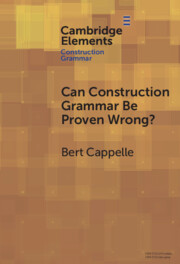Element contents
Can Construction Grammar Be Proven Wrong?
Published online by Cambridge University Press: 05 January 2024
Summary
- Type
- Element
- Information
- Series: Elements in Construction GrammarOnline ISBN: 9781009343213Publisher: Cambridge University PressPrint publication: 01 February 2024
References
- 2
- Cited by



